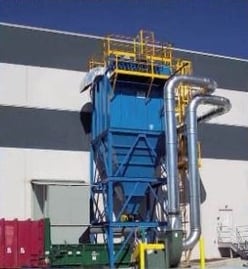 For many dust collection system installers and air pollution control (APC) contractors, cartridge collectors represent the “bread and butter” of their business. However, the main limitation of these collectors is they are only designed to handle lighter dust loads, like those associated with light manufacturing, including typical metal cutting and welding, mixing and screening of powders, in addition to woodworking operations, painting, and general room ventilation. When used on more “aggressive” collection applications and/or where the dust load is heavy, providing a cartridge collector might result in more frequent (and expensive) filter changes and unscheduled maintenance shutdowns.
For many dust collection system installers and air pollution control (APC) contractors, cartridge collectors represent the “bread and butter” of their business. However, the main limitation of these collectors is they are only designed to handle lighter dust loads, like those associated with light manufacturing, including typical metal cutting and welding, mixing and screening of powders, in addition to woodworking operations, painting, and general room ventilation. When used on more “aggressive” collection applications and/or where the dust load is heavy, providing a cartridge collector might result in more frequent (and expensive) filter changes and unscheduled maintenance shutdowns.
Further, pleated cartridge elements aren’t suitable for sticky dusts, dusts that clump easily, or where the gas stream is very humid. Generally, cartridge filters are used as point collection devices for individual manufacturing processes, but they are sometimes used for capturing dust from multiple processes throughout a facility. In cases like these, clogged filters could literally shut down an entire production line. In contrast, a baghouse is much more forgiving of higher dust loads and needs less frequent filter replacements, so it can offer your customer a more cost-effective approach to dust collection.
Baghouse applications
Baghouses are an appropriate solution for a wide variety of manufacturing processes, including chemical processing, rubber compounding, minerals processing, plastics/resins processing and recycling. They are also used for bin venting applications; filter receivers, general ventilation of areas with heavy dust loads, exhaust from processes including thermal processing equipment such as dryers, calciners, kilns, furnaces, and oxidizers; and exhaust from size reduction processing equipment such as crushers, mills, and classifiers; along with many other applications.
When to recommend a baghouse
How can you know when a baghouse offers a better solution than a cartridge collector system for your customer’s application? Here are some clear indicators:
- The application involves heavy dust loads. Loads greater than 5 grains per dry standard cubic foot (gr/DSCF) would be considered heavy. These types of loads are typically found in facilities for minerals and chemicals processing, foundries, etc. If a cartridge collector is used in these types of applications, typically a pre-cleaner such as a cyclone is added to reduce the dust load to the dust collector. This adds capital costs, increased energy consumption due to a higher pressure drop in the system, a second point from which to collect solids, and more maintenance requirements.
- Higher temperatures are involved. For dust streams at temperatures higher than 275°F (~135°C) a baghouse is generally more cost effective.
- Operating static pressure is higher than 30 inches water gauge (w.g.).
- Corrosive gases are present. Any gas with acidic constituents would be considered corrosive.
- Highly explosive or combustible dusts are present. Many common food products such as grain, flour, starch, sugar, powdered milk, cocoa, coffee, and pollen pose an explosive risk if dispersed into a dust cloud. Powdered metals have higher explosive properties, like aluminum, magnesium, and titanium. A higher strength baghouse vessel is generally indicated for higher Kst (ST-3) dusts. For more information on explosive/combustible dusts, refer to the OSHA® Fact Sheet: Hazard Alert: Combustible Dust Explosions.
- Dust collection in heavy industries that run 24/7operation require caution, and a properly designed baghouse requires less maintenance.
- A customized dust collection solution is required. Most cartridge collectors are available in standard models only. Attempting to get a customized solution from a cartridge collector manufacturer is likely to be an expensive proposition. In contrast, baghouses can be readily customized for specific situations, such as height or plan area restrictions at the installation site. Baghouses also offer a wider range of options for construction materials, making it simpler to adapt to the temperature and chemistry requirements of a specific application. Although many cartridge collectors are only compatible with the original manufacturer’s expensive brand of filters, replacement baghouse bags are widely commercially available.
Cashing in on baghouse sales opportunities
How can you take advantage of the baghouse sales opportunities you encounter? Here are some ways to get started:
- Educate yourself about baghouse technology and how it has evolved over the last few decades. Sly’s free Baghouse 101 training videos are a great place to get started. To see how far we’ve come, check out our support for legacy systems that are still in service.
- Look for suppliers who can offer your installation customers the flexibility of custom systems that are tailored to their specific applications and dust collection conditions.
- Learn the questions you have to ask the customer in order to build an RFQ for a baghouse system. These include questions about air flow, dust types, dust loading, particle size, bulk density of the dust, installation constraints, location (indoors or outdoors), geometry restrictions, etc.
Conclusion
Baghouses represent a significant potential source of new business for your service. Taking the time necessary to understand what they can offer your customers will pay big dividends. Sly can help you with any questions. Contact us or check out our Baghouse 101 video training series to help you make sure you’re giving your customers the best solution.
Tags: baghouse




